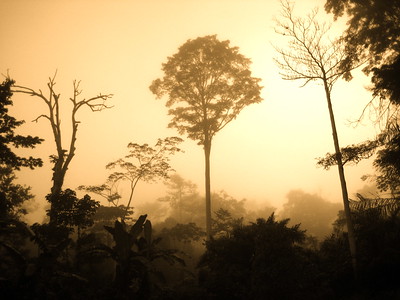Valuing natural capital and its distribution in the Congo Basin forests

Download
Conserving tropical forests is essential for global environmental sustainability, yet aligning conservation goals with economic development remains a major challenge — particularly in low-income, forest-rich countries. This paper provides new empirical insights into the economic value of the Congo Basin forests and how the supply of this value is distributed across categories of rightsholders (agents who hold tenure, whether that be legal or more traditional forms), thereby linking values to the different groups who make management decisions about the forest.
The authors estimate the gross annual value of the Congo Basin forests in 2019 at US$7.8 billion, comparable to 6.3% of regional GDP. This estimate comprises all forest values which are currently transacted on markets, except non-timber forest products: values are estimated for industrial timber, artisanal timber, wood fuel, bushmeat and tourism. The distributional consequences of three possible valuation approaches for carbon are presented separately. The study highlights the importance of understanding how natural capital is distributed across rightsholders — a key question for development policy and the design of natural capital finance in forested regions.
Key points for decision-makers
- Tenure systems determine the ownership and usage rights of land. Because most ecosystem services are produced at specific locations, mapping tenure makes it possible to assess the distributional implications of policies that affect natural capital (e.g. for specific economic actors and income groups, or for specific areas managed by a given actor/group). The distributional consequences (winners and losers) of natural capital policies influence their design and success.
- Tenure systems in the Congo Basin are complex, with potentially overlapping claims from legally recognised (statutory) tenure, which may expand or replace colonial tenure systems, and older systems of customary tenure. The authors produce a new map of customary tenure across the Congo Basin to enable their distributional analysis.
- The Congo Basin forests generated an estimated US$7.8 billion in 2019 (gross output value), evenly split between lands under legally recognised statutory tenure and areas under alternative tenure arrangements (notably customary tenures surrounding rural settlements). This figure indicates the value of ecosystem services that are currently transacted on markets; if forest land was allocated to another use, for example conservation to fight climate change, this is the economic value that Congo Basin rightsholders would forego.
- On average, the per unit value of customary tenures ($53.33/ha) is surprisingly close to that of industrial forestry concessions ($56.43/ha). Community forests have the highest values per unit of land ($159.19/ha). The paper applies a new approach to separating the timber values produced by foreign-owned versus domestic-owned concessions.
- Most of the value of customary tenures arises in informal markets for fuelwood (48% of total customary tenure value) and bushmeat (28%), underscoring the forests’ role in meeting basic needs such as cooking and protein provision. Interestingly, tourism services mostly arise in customary tenures despite emphasis on high-profile protected areas in the tourism sector.
- Most estimated value for protected areas originates in bushmeat production (60%, compared to 11% for tourism), due to the proximity of many protected areas to forest-dependent rural populations having customary claims to forest access. This points to challenges with conservation models based on strict protection, and the importance of linking local benefits to conservation outcomes.
- Simplified versions of the two dominant accounting approaches for valuing carbon (as used by Reducing Emissions from Deforestation and forest Degradation, or REDD+, schemes) produce very different distributional results, pointing to the political negotiations at the heart of global efforts to preserve the Congo Basin forests for climate regulation. A scientifically robust alternative (‘net flux’ accounting) literally puts a price on carbon but raises serious equity concerns in global climate policy.
- The authors recommend three priorities for leveraging natural capital in Africa: accelerate the use of natural capital accounting (NCA) in decision-making; integrate financial services with ecosystem markets; account for political economy in natural capital policy. Methodological innovations are suggested for national governments interested in improving information about natural capital under budget constraints.

